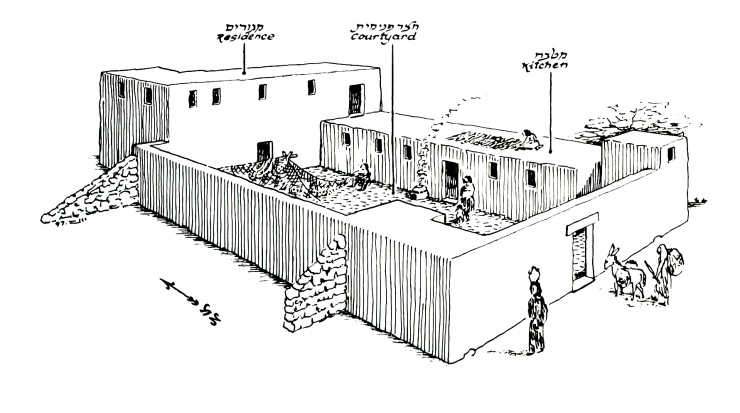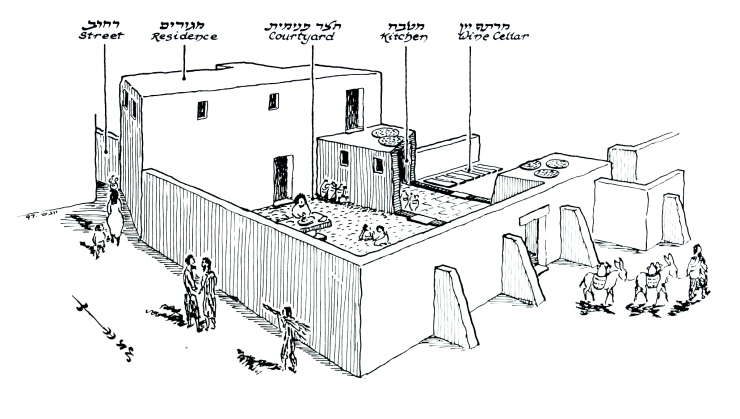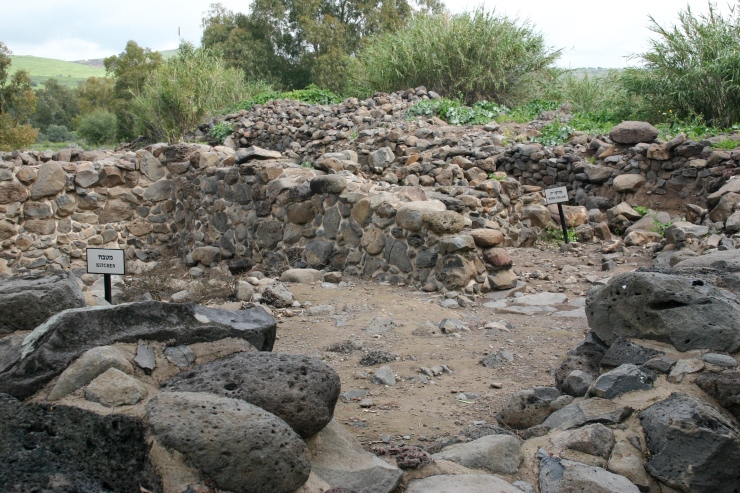|
The name
Bethsaida is of Aramaic origin, meaning the "fishing house"
or "the house of fishing". This town was located on the
north shore of the Sea of Galilee east of the
Jordan River.

Artist's
rendering of the fisherman's house uncovered at Bethsaida
(See
photo below of actual excavation)
Though we
know that Peter later lived in Capernaum;
Peter and his brother Andrew (fishermen), as well as Philip, were
originally from Bethsaida.
Matthew
4:18-20 As Jesus was walking beside the Sea of Galilee, he saw two
brothers, Simon called Peter and his brother Andrew. They were
casting a net into the lake, for they were fishermen. 19 "Come,
follow me," Jesus said, "and I will make you fishers of
men." 20 At once they left their nets and followed him. (NIV)
John
1:43-46 The next day Jesus decided to leave for Galilee. Finding
Philip, he said to him, "Follow me." 44 Philip, like Andrew
and Peter, was from the town of Bethsaida . 45 Philip found Nathanael
and told him, "We have found the one Moses wrote about in the
Law, and about whom the prophets also wrote - Jesus of Nazareth, the
son of Joseph." 46 "Nazareth! Can anything good come from
there?" Nathanael asked. "Come and see," said Philip. (NIV)
John
12:20-22 Now there were some Greeks among those who went up to
worship at the Feast. 21 They came to Philip, who was from Bethsaida
in Galilee, with a request. "Sir," they said, "we
would like to see Jesus." 22 Philip went to tell Andrew; Andrew
and Philip in turn told Jesus. (NIV)
The later
passage, in John 12, showed that Greeks felt more comfortable
approaching Philip, who was from this mixed town of both Gentiles and
Jews. Some have speculated that there may have been two Bethsaidas,
one west of the Jordan (perhaps at Ain et-Tabigha) and another east
(the one we are certainly considering here), but it is not necessary
from the text (and highly improbable because of their close
proximity). The earlier reference, in John 1, ties all of these
disciples to the same Bethsaida. Certainly, the later reference to
"Bethsaida in Galilee", or literally "Bethsaida (of)
Galilee", doesn't have to mean a Bethsaida in the Roman
territory of Galilee (which was at that time only west of the
Jordan), rather it can be solely a reference to Bethsaida close
proximity to the Sea of Galilee - a geographic fact that would have
been of interest to the immediate audience of John's gospel.
Alternately, it should be noted that the Roman district of Galilee
once encompassed the entirety of Galilee including this location of
Bethsaida. Without question Bethsaida was in the historic Israelite
area referenced as Galilee. To those from Judea, all Jews from this
whole northern region were Galileans.

Ruins
of the fisherman's house. Three signs mark...
Left:
Residence. Center: Courtyard. Right: Kitchen.
The
positioning of the eastern wall, as found, testifies that it was
destroyed by an earthquake.
Bethsaida
was singled out by Jesus for its unbelief, together with the other
northern Galilee cities of Capernaum and
Korazin (alt. Chorazin). This entire region had seen and heard more
of Jesus' miracles and words than anywhere else, yet had (as a whole)
rejected Jesus.
Matthew
11:20-24 Then Jesus began to denounce the cities in which most of his
miracles had been performed, because they did not repent. 21 "Woe
to you, Korazin! Woe to you, Bethsaida! If the miracles that were
performed in you had been performed in Tyre and Sidon, they would
have repented long ago in sackcloth and ashes. 22 But I tell you, it
will be more bearable for Tyre and Sidon on the day of judgment than
for you. 23 And you, Capernaum, will you be lifted up to the skies?
No, you will go down to the depths. If the miracles that were
performed in you had been performed in Sodom, it would have remained
to this day. 24 But I tell you that it will be more bearable for
Sodom on the day of judgment than for you." (NIV) [Also Luke 10:13-14].
The Gospel
of Mark notes that Jesus sent the disciples to Bethsaida immediately
following the feeding of the five thousand.
Mark
6:39-46 Then Jesus directed them to have all the people sit down in
groups on the green grass. 40 So they sat down in groups of hundreds
and fifties. 41 Taking the five loaves and the two fish and looking
up to heaven, he gave thanks and broke the loaves. Then he gave them
to his disciples to set before the people. He also divided the two
fish among them all. 42 They all ate and were satisfied, 43 and the
disciples picked up twelve basketfuls of broken pieces of bread and
fish. 44 The number of the men who had eaten was five thousand. 45
Immediately Jesus made his disciples get into the boat and go on
ahead of him to Bethsaida, while he dismissed the crowd. 46 After
leaving them, he went up on a mountainside to pray. (NIV)

Artist's
rendering of a courtyard style home in Bethsaida
(See
below for photo of actual excavation)
It was
Mark who also notes the amazing healing of the blind man at
Bethsaida. This man was not from Bethsaida, as Jesus later sent him
home, specifically telling him to not go into the village. It's
significant that Jesus took him outside of the town to do the
miracle, perhaps already an indictment on the unbelief of this place.
Mark
8:22-26 They came to Bethsaida, and some people brought a blind man
and begged Jesus to touch him. 23 He took the blind man by the hand
and led him outside the village. When he had spit on the man's eyes
and put his hands on him, Jesus asked, "Do you see
anything?" 24 He looked up and said, "I see people; they
look like trees walking around." 25 Once more Jesus put his
hands on the man's eyes. Then his eyes were opened, his sight was
restored, and he saw everything clearly. 26 Jesus sent him home,
saying, "Don't go into the village." (NIV) (Note that the
word here translated as "village" also means "small
town", still a valid use in regards to a small city, perhaps as
emphasis that it was smaller than neighboring cities such as
Capernaum. Josephus refers to it as the village given the dignity of
a city - See quote later in this article).
Luke's
reference to Bethsaida showed that very early in Jesus' ministry it
was being used (along with Capernaum) as a base of operations,
especially when necessary to stay out of the reach of Herod. Herod
ruled over the Roman province of Galilee, but Bethsaida (being across
the Jordan) was in the territory of the tetrarch Philip. Note the
sequence of events; (1) Jesus sends the twelve out (from Capernaum),
(2) This attracts the attention of Herod, (3) They return to Jesus at
Capernaum, (4) They leave for Bethsaida (outside the reach of Herod)...
Luke
9:1-11 When Jesus had called the Twelve together, he gave them power
and authority to drive out all demons and to cure diseases, 2 and he
sent them out to preach the kingdom of God and to heal the sick. 3 He
told them: "Take nothing for the journey - no staff, no bag, no
bread, no money, no extra tunic. 4 Whatever house you enter, stay
there until you leave that town. 5 If people do not welcome you,
shake the dust off your feet when you leave their town, as a
testimony against them." 6 So they set out and went from village
to village, preaching the gospel and healing people everywhere. 7 Now
Herod the tetrarch heard about all that was going on. And he was
perplexed, because some were saying that John had been raised from
the dead, 8 others that Elijah had appeared, and still others that
one of the prophets of long ago had come back to life. 9 But Herod
said, "I beheaded John. Who, then, is this I hear such things
about?" And he tried to see him. 10 When the apostles returned,
they reported to Jesus what they had done. Then he took them with him
and they withdrew by themselves to a town called Bethsaida , 11 but
the crowds learned about it and followed him. He welcomed them and
spoke to them about the kingdom of God, and healed those who needed
healing. (NIV)
Having
mentioned that Philip was ruler over the area of Bethsaida (Luke
3:1), Bethsaida was considered to be an important location in his
rather insignificant territory. He had Bethsaida rebuilt in honor of
Julia, the daughter of Caesar Augustus, and subsequently made it into
his capital city. At his death, Philip is said to have been buried there.
When
Philip also had built Paneas, a city at the fountains of Jordan, he
named it Cesarea. He also advanced the village Bethsaids [Bathsaida],
situate at the lake of Gennesareth [north side of the Sea of
Galilee], unto the dignity of a city, both by the number of
inhabitants it contained, and its other grandeur, and called it by
the name of Julias, the same name with Caesar's daughter. (Josephus:
Antiquities of the Jews 18.2.1)
Now
Jordan's visible stream arises from this cavern [at Panium or
Caesarea Philippi], and divides the marshes and fens of the lake
Semechonitis [Hula Lake]; when it hath run another hundred and twenty
furlongs, it first passes by the city Julias [Bethsaida], and then
passes through the middle of the lake Gennesareth [Galilee]; after
which it runs a long way over a desert, and then makes its exit into
the lake Asphaltitis [Dead Sea]. (Josephus: Wars of the Jews, 3.10.7)
Regardless
of its former glory, as is fitting to a city cursed by Jesus,
Bethsaida was completely destroyed and uninhabited.

This
house (see artist's rendering above) was built during the late
Hellenistic or early Roman period.
Still
in use after the time of Christ, it is an example of "the
courtyard style."
Four
wine jars were found in the wine cellar.
A
large shard incised with a cross was found in the doorway.
Posted
Signs in the photo -- left: Kitchen. right: Wine Cellar
|